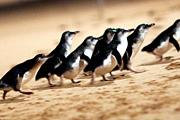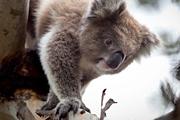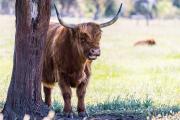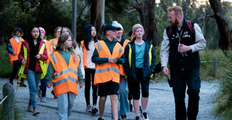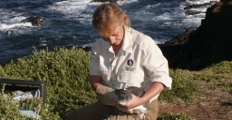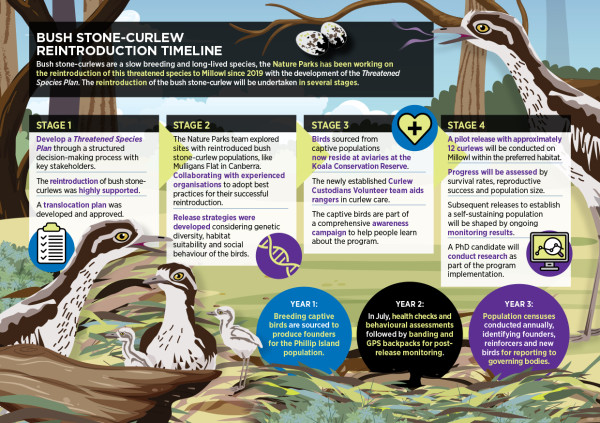The bush stone-curlew is a ground dwelling, nocturnal bird with prominent yellow eyes that are ideal for nighttime hunting. It has grey-brown colouring on its upper region with a white belly and black streaks throughout. Its long legs give it height and fast mobility to observe and avoid predators. The bush stone-curlew is renowned for its haunting call, often described as a high-pitched wail. Found throughout most of Australia, numbers have drastically reduced in south-eastern regions since European settlement, their status is now Critically Endangered in Victoria.
The Koala Conservation Reserve is currently home to bush stone-curlews housed in two large aviaries where visitors can view and learn about the species and their proposed recovery on Milawul.
Download bush stone-curlew infographic here.
Returning the bush stone-curlew to Phillip Island (Milawul)
The first groups of bush stone-curlews from Mt Rothwell Sanctuary were released on Phillip Island (Milawul) in August 2024, marking the commencement of landmark study in a collaboration between the Nature Parks, Odonata Foundation and the Australian National University. The program is sponsored by the Penguin Foundation. The long-term goal is to improve the viability of the Critically Endangered bush stone-curlew in south-eastern Australia.
Before birds were translocated and released, each bird was checked for body condition, assessed for anti-predator behaviours and fitted with a unique leg flag and GPS backpack to allow researchers to track and monitor movements after release.
Careful consideration was given to the release sites. Suitable habitats included canopy cover, a mix of ground cover and fallen timber that provides shelter while allowing birds to spot potential predators, adequate food availability, existing predator control, distance from roads, and accessibility for the Research team.
A total of 12 bush stone-curlews were released. The research team has been closely monitoring the birds using custom-fitted GPS backpacks and individual identification bands to track their habitat use and movement patterns.
To learn more about the program, read the latest Conservation News.
An agreement with Odonata Foundation set out the framework and major areas of focus for cooperation including the recovery plan for the bush stone-curlew, the SEASON program, co-management of wildlife populations, potential joint funding bids and potential co-management of new sites. You can find out more about the Odonata Foundation here.
View a snapshot video of reintroduction here:
Establishing the bush stone-curlew population on Phillip Island (Milawul)
In November 2024, health checks were conducted, including measuring body weight and condition, presence of external parasites, a visual assessment of general health, and a check of the leg bands and GPS devices. Health checks indicated that the bush stone-curlews are adapting well to the new environment.
The trial is proving to be successful with an 83% survival rate, a high rate in comparison to other reintroductions of the species. The birds have settled into areas around Oswin Roberts and the Koala Conservation Reserve. A tactic employed during the reintroduction was clipping the wing feathers to limit flying. This approach has helped them settle and has been shown to improve survival rates in the early stages of a reintroduction. The birds will regain the ability to fly when their feathers grow back.
The bush stone-curlews move around the island between dusk and dawn, often using established pathways and road networks. Unfortunately, we have lost two birds due to road incidents; a reminder to slow down when driving on Phillip Island (Milawul) at all times.
Due to the success of the trial phase, we are moving into the next phase of the program which aims to establish a self-sustaining population with the release of more birds. We do anticipate an increase in bird movement around the island as more are released. This may be observed along pathways and roads as they establish in their new home ranges.
The bush stone-curlew is Critically Endangered in Victoria, which contrasts with populations in northern Australia. We do not expect to see the same numbers in Victoria as are seen in Queensland. Phillip Island is one of several locations where bush stone-curlew reintroductions are being undertaken within south-eastern Australia as part of a long-term recovery program led by Odonata Foundation, the Nature Parks and the Australian National University.
Call to action
You can help the bush stone-curlew reintroduction program by:
- Slowing down when driving – dusk to dawn is when birds are most active – remember the birds can’t fly yet.
- Keep dogs on a leash and cats contained at all times.
- Leave fallen logs on the ground for habitat.
- Report sightings of the bush stone-curlew here or email community@penguins.org.au
Reintroduction research
A research study to test and evaluate reintroduction strategies for bush stone-curlews is being conducted by a PhD candidate, Paula Wasiak, from the Species Coexistence Lab at the Australian National University.
The research will assess the trial and refine the tactics for future releases over a three-year period. The progress of the birds will be assessed based on their survival rates, habitat use, movement patterns and reproductive success. The ongoing monitoring is also supported by two internship students from Deakin University, providing positive outcomes for both the Nature Parks and the students.
View the reintroduction overview video here:
Our role
In 2019, Phillip Island Nature Parks launched its 30-Year Conservation Vision – Beyond the Horizon, recognising the exceptional opportunity for the organisation to contribute to significant conservation milestones for Victoria through rewilding and the protection of threatened flora and fauna species. Following this, a Threatened Species Plan was developed in consultation with key stakeholders representing a diverse range of parties involved in managing and coexisting with threatened species on Phillip Island.
This plan looked at both current vulnerable species and the recovery of threatened fauna that were once found on Phillip Island, with the bush stone-curlew identified as a priority species.
It is important to note that:
- The program will contribute to the overall recovery of the bush stone-curlew in south-eastern Australia through collaborative partnerships with Odonata Foundation and the ANU.
- It’s a part of a commitment by the Nature Parks to recover biodiversity on Phillip Island through implementation of the Threatened Species Plan.
- The primary outcome is to successfully establish a self-sustaining population of bush stone-curlews to restore ecological function on Phillip Island.
- It’s a long-term program, where significant results are expected to take time.
- This species is difficult to recover, and we expect setbacks and challenges along the way. Success is not guaranteed.
- The program cannot succeed without the community’s support and involvement.
Location
Phillip Island (Milawul) is part of the bush stone-curlew’s indigenous home range – they were last seen on the island in the 1970s – and there are areas on the island with broadly suitable and intact habitat for the species. The removal of red foxes, alongside a strong history of robust conservation governance, management and research means this location can act as a stronghold for the species.
Timeline
How
- The aim is to translocate up to 100 birds over three years, depending on the success of various breeding programs and the availability of birds.
- A range of approvals is required, including endorsement of an expert government panel (Translocation Evaluation Panel), an Animal Ethics Committee approval and a state government permit.
These approvals consider the conservation value of the project, a comprehensive range of risks, the project’s feasibility, animal welfare impacts and stakeholder support. This included overseeing and approving a genetic study, collaborative agreement with Odonata and the ANU, and evaluating the best approach for the reintroduction of the species. - A feasibility study was undertaken and recommended that adult birds from the Mt Rothwell captive colony be selected for relocation, following a 12-month pre-conditioning period.
- The reintroduction of the species is using strategies and tactics across several stages including pilot studies, and primary, secondary, and tertiary releases and will be supported by ongoing monitoring, post release evaluation, further research, health checks, and population census.
- Some of the tactics being used include release of limited numbers, drip-feed release, constrained release areas, feather sampling, bird bands, wing-clipping, song meters and GPS-backpacks.
Get Involved
Phillip Island Nature Parks have made a long-term commitment to the project, and it will contribute to the overall recovery of the bush stone-curlew in south-eastern Australia. You can get involved with this program by:





